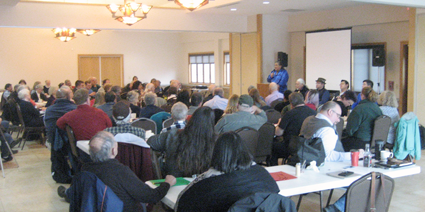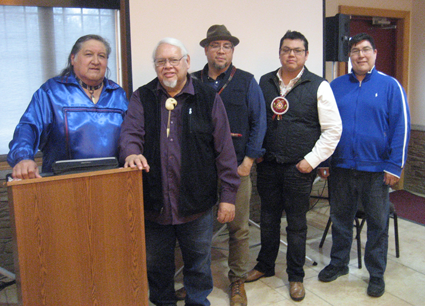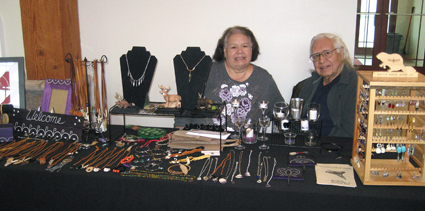Featured News - Current News - Archived News - News Categories
By Old Fort Niagara Association
On March 30, 90 people gathered at the Tuscarora Nation House for a Native American History Symposium sponsored by the Old Fort Niagara Association. The event featured three well-known Native American scholars, and a panel discussion. The program’s theme centered on the Native view of Fort Niagara during the 18th and early 19th centuries.
The first speaker of the day was Michael Galban, an expert in Native American material culture. Galban specializes in eastern woodland cultures and has been actively working with the many Haudenosaunee communities to preserve examples of the ancient arts for over 20 years.
He is currently the curator and interpretive programs assistant for the Seneca Art and Culture Center at Ganondagan State Historic Site in Victor. He is also co-founder of the Haudenosaunee Living History Society, which is dedicated to preserving and fully understanding Iroquois history. Galban’s work also includes costume and cultural consultation for film and television, and he is the author of “Amazing Journey – the Historical Art of Robert Griffing,” and other publications on Haudenosaunee material culture. He curated the 2017 exhibit “Hodinöhsö:ni’ Women: From the Time of Creation” at the Seneca Art and Culture Center.
Galban discussed ancient Native legends about the Niagara River and chronicled the coming of the French to the region in the late 17th century. He concluded his talk with an overview of the role of Native people in the siege of 1759.
Next, Jamie Jacobs, collections assistant for the Rochester Museum and Science Center, spoke about the role of Native people during the American Revolution. Jacobs, a Tonawanda Seneca, is an expert in Iroquoian culture, ceremony and history, and is proficient in Seneca and other Iroquoian languages. Jacobs has worked on grant projects on Seneca and Iroquoian culture related to the Native American Graves Protection and Repatriation Act, including processing burial items for repatriation.
His talk recounted how the Haudenosaunee people sought to remain neutral in the early years of the American Revolution. As the war progressed, however, many Natives supported the British as protectors of their lands. He concluded with the impact of the war on Native communities.
At this point the audience broke for lunch, which was Native fare prepared by Patty Fisher.
Following the break, the third speaker, Dr. Richard Hill, discussed the Fort Niagara Peace Conference of 1764 and the role of the Haudenosaunee people in the War of 1812. Hill is a Tuscarora of the Beaver Clan, residing at Six Nations of the Grand River Territory. Hill formerly taught at SUNY Buffalo in American studies for 20 years. He also served as assistant director of public programs at the National Museum of the American Indian, Smithsonian Institution.
Hill was the chairperson of the Six Nations Legacy Consortium that organized commemorative events on the War of 1812, the Treaty of Niagara of 1764, and was a member of the planning group for Landscape of Nations, a memorial to the Indigenous involvement in the War of 1812 that was installed in Queenston Heights, Ontario. He is the author of the book, “War Clubs and Wampum Belts: Hodinohsoni Experiences of the War of 1812.”
At the end of the day, speakers gathered to entertain questions from the audience. This resulted in a lively discussion that drew upon the many oral traditions passed down through Native communities.
By all measures, the event was a success, with lively presentations, dynamic discussions and good food.
































